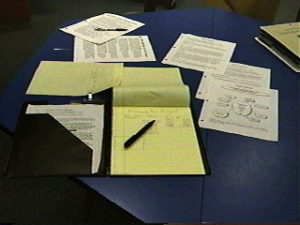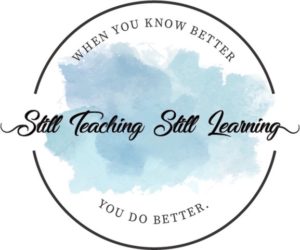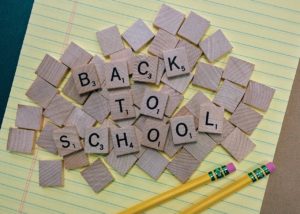
Every teacher wants to keep kids engaged and help to build a growth mindset in their students. Today’s post is all about ways to do that. Here are 7 of my favorites plus a few more I want to try this year
7 FAVORITE ACTIVITIES
1 – Morning meeting or morning rituals are a great way to start the day off on a positive note.
One of my favorites is to use Wonderopolis one or two days a week. While each Wonder has an entire lesson plan built around it, you can do as much or as little as you choose, based on the time you have available. This is a great way to engage kids with science and informational text.
For more about starting morning meetings (or class circles), see my post HERE.



2 – You may have heard about Kagan cooperative learning strategies. These strategies have been around for a long time and are proven to work.
Some benefits of cooperative learning strategies:
~kids develop better social skills and a spirit of cooperation
~improved self-esteem in students at all levels of achievement
~improved engagement with learning
~improved classroom community
~fewer discipline problems
~better empathy for others
THIS book is the “Bible” for all of the strategies. But if you are looking for just a few of the best strategies to try, here is “The Essential 5: A Starting Point for Kagan Cooperative Learning.”
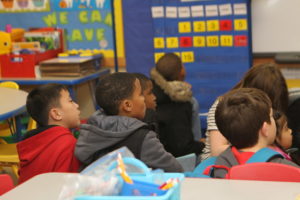


3 – I created a list of 20 strategies for active learning. I keep it in my plan book so that I can remember to incorporate them whenever possible. Click below to download my list!
4 – Growth mindset is such an empowering concept for our kids. For one thing, learning about how the brain grows and changes is fascinating. Changing our “self-talk” from “I’m just no good at this” to “I’ll try something else and I WILL learn how to do this” is a game-changer for many students (and teachers!).
There are lots of great resources out there for growth mindset, but one of my favorites is Angela Watson’s resource on Teachers Pay Teachers HERE. It has detailed lesson plans, great videos to watch with your class, and a student booklet for writing and reflection. I use this resource at the beginning of the year. Then we refer back to what we learned throughout the year.
I have used some of the growth mindset TED Talk videos from THIS SITE and plan to check out the rest of them this year!
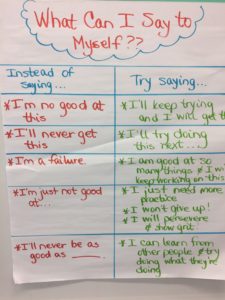


5 – Growth mindset is empowering for students and teachers. So is goal setting. You can have students set goals for themselves in any academic area, set goals for improving work habits, and set goals for social skills. You might try brainstorming some lists of goals in different areas so your students get some ideas.
As you brainstorm goals lists, think about trying to make the goals small enough to be achievable in a short time frame.
For instance, if a student suggests “get better at reading” for a reading goal, what could they do this week to get better at reading? Read for 20 minutes at school and 20 minutes at home? Make a list of books they want to read when they finish this one? Stop and figure out words instead of just skipping over them? Reread when something is confusing?
Once goals are set, it’s important to take a few minutes to review progress. Some teachers do this daily at the end of the day as part of their routine. I try to do it on Friday afternoons, but I have also found Monday mornings to be a good time. Figure out a time that works best for you and your class.
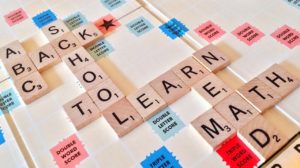


6 – Use music for transitions! This is something I have done sporadically, but really want to do more of it this year.
I’ve seen some teachers use specific songs for certain transitions (coming to the meeting area in the morning, transitioning from one subject to another, cleaning up at the end of the day, etc.). This way, when students hear the song, they know what they are supposed to be doing.
Other teachers use songs of a certain length and students are supposed to be “finished” with the transition by the end of the song.
I love using these playlists from Josie Bensko of Maniacs in the Middle!



7 – Use Twitter & Instagram with your classes. We have a fifth grade Twitter account, which is public, and a fifth grade Instagram account, which is private. We notify families about both accounts and encourage them to follow us. It takes a moment to “approve” the followers on Instagram, but it reassures families that their children’s photos are not just out there for everyone to see.
I especially like using student quotes about classroom learning on Twitter. We post their quote using student first names only. So if we are tweeting about how some math concept is helpful, or what we think about a character in a class read-aloud, I’ll ask students to think about what they might want to say. Then I will often draw a name or use a student checklist and choose someone to give us their thoughts for a tweet. Sometimes we combine two students’ thoughts into one tweet and use both names. Kids love seeing their ideas being shared with the “world” and families love seeing what the kids have to say.



With Instagram, we take pictures on field trips and at big school events, but families also love seeing pictures of kids during independent reading or participating in a science experiment or working on math problems.
Another good “side effect” of this practice is that you are modeling positive social media use with your students. You get some opportunities to sneak in a few more reminders about digital citizenship in the process of using social media in a fun way.



6 ACTIVITIES I AM GOING TO TRY THIS YEAR!
1 – I love the Curriculum Corner website and use it all the time. I recently found August daily welcome messages on their site and want to try that out this year.
Basically, it’s a welcome message to be posted on the board when students enter your classroom in the morning. (You may be familiar with morning message for lower elementary grades – this is similar.)
It starts with a quote of the day, which you could then discuss during class circle or morning meeting. Then there is a direction for “greeting a friend” (with a talk topic) and “get moving” with a stretch and quick exercise. You could brainstorm and make a chart of stretches and exercises that would be most appropriate for your class.
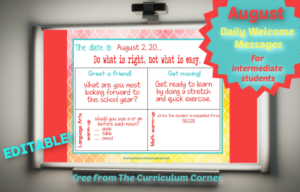


Source: The Curriculum Corner
The next part is an editable language arts warmup and editable math warmup.
They have a set for August posted already and they will post new sets each month.
Here is the set for grades 4-6.
Here is the set for grades 1-3.
And here is the set for Kindergarten.
2 – If you are not a part of Facebook teacher groups, you’re missing out! I participate in several groups and get such great ideas from amazing teachers. I keep hearing about using podcasts with students and I want to try that out this year.
The 6 Minute Podcast sounds interesting. I am planning to use this at the end of the day as “incentive” to get cleaned up and packed up quickly.
I would love to hear how you use podcasts and which ones you like!



3 – I have also heard good things about using CNN 10 to discuss current events.
If you use this, please tell me how you use it. I’m looking for ideas for the best ways to incorporate it in our busy day!
4 – Another great website for all kinds of life advice is Lifehack. I noticed this post about the 17 best TED talks for kids!
The criteria for making this list included the following:
~they’re short enough to keep kids engaged (shorter than 15 minutes – some are only three minutes);
~they include life lessons that are important for kids today;
~they’re kid-friendly;
~they’re interesting.
I’m going to have one of these ready to go each week and fit it in whenever we have a few minutes.



5 – I am a big fan of Brene Brown and her work. If you are not familiar with her books, check them out HERE.
I recently heard about her resource for teachers called “Daring Classrooms” in a Facebook teacher group.
I haven’t explored all the resources yet, but I want to try some this year. The first thing I plan to do is download some of the posters HERE and get them made for my classroom.
Here’s an example from the site:
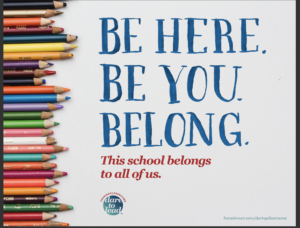


Do you use this or have ideas for it? I’d love to hear your thoughts!
6 – Larry Ferlazzo is a very helpful teacher blogger. You can read his work HERE. He also posts “Classroom Q & A with Larry Ferlazzo” on Education Week.
I came across an old post of his HERE in which he talks about engaging all students in a lesson. He shares some tips from his vice principal:
In order to elicit whole-class engagement, we need to ensure that we are implementing a series of factors that elevate our students’ focus and level of concern. We’ll refer to this series as “TAPN”. After all, our goal is to get all of our students to “tap in” to the lesson. “TAPN” refers to the words time, amount, public, and novelty.
Time: tell students how much time they have to complete a task. (This can be tricky because you want to give them a “do-able” amount of work in a fairly short amount of time. You’ll have to play around with this.) Students should feel a sense of urgency. (In other words: they don’t have all day to get it done!)
Amount: tell students how much they need to complete. For example: read one paragraph, solve two problems, write one sentence, etc.
Public: students need to know that they will be asked to share their work with peers somehow (as partners, with a small group, in front of the class, etc.)
Novelty: change up the ways that students respond. This keeps the energy up in your classroom.
He explains:
The first time you ask them to turn to a partner and share, you’ll feel a fresh energy in the room. The sixth, seventh and eighth time in a row that you ask them to do so, however, you’ll likely hear a growing sigh. You can mix it up by having them write their answer down and be prepared to share it with the group, write it on a mini white board and be ready to hold it up or just think to themselves for a few moments before they share out. Small changes of routine increase the motivation to attend to the task at hand.
When I find new ideas to try, it gives me energy and gets me excited about the upcoming year. I hope these ideas have done the same for you!
What are you going to try this year?
